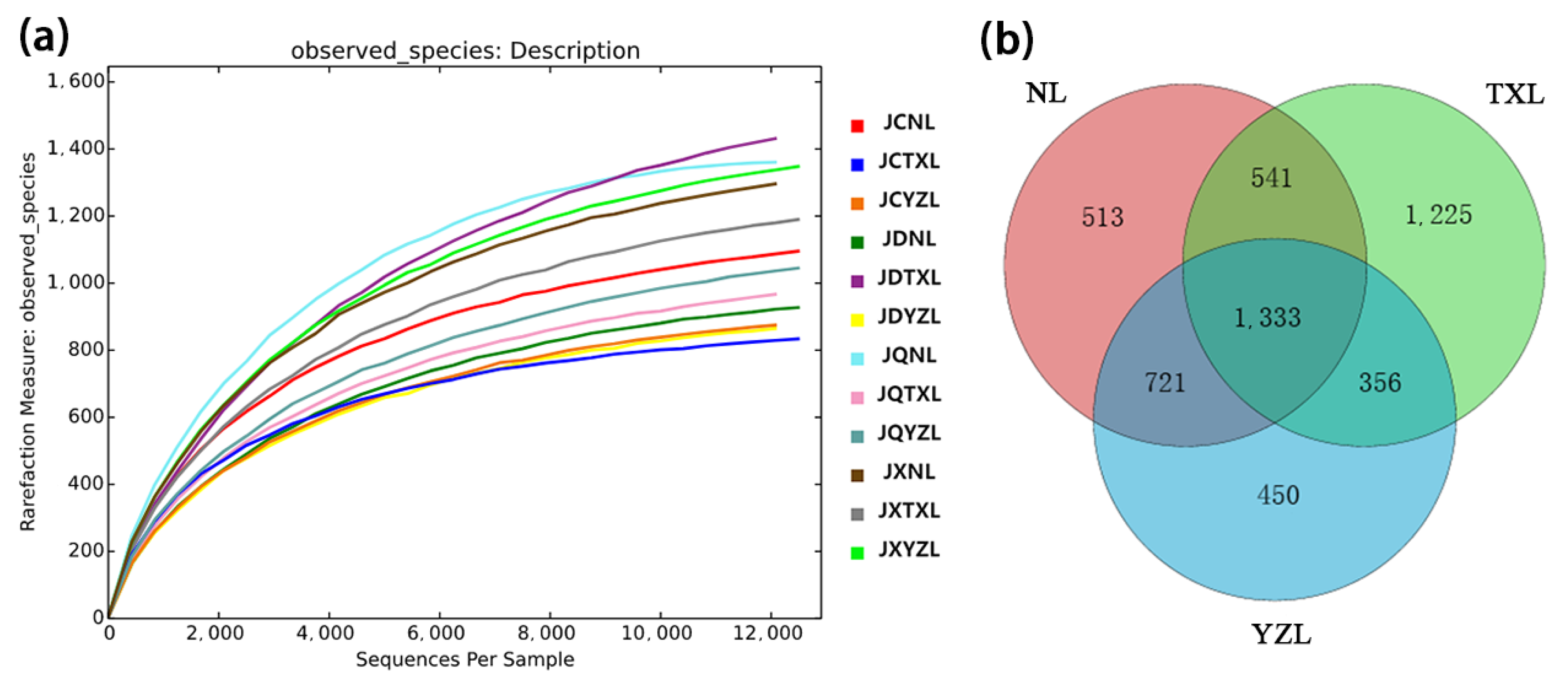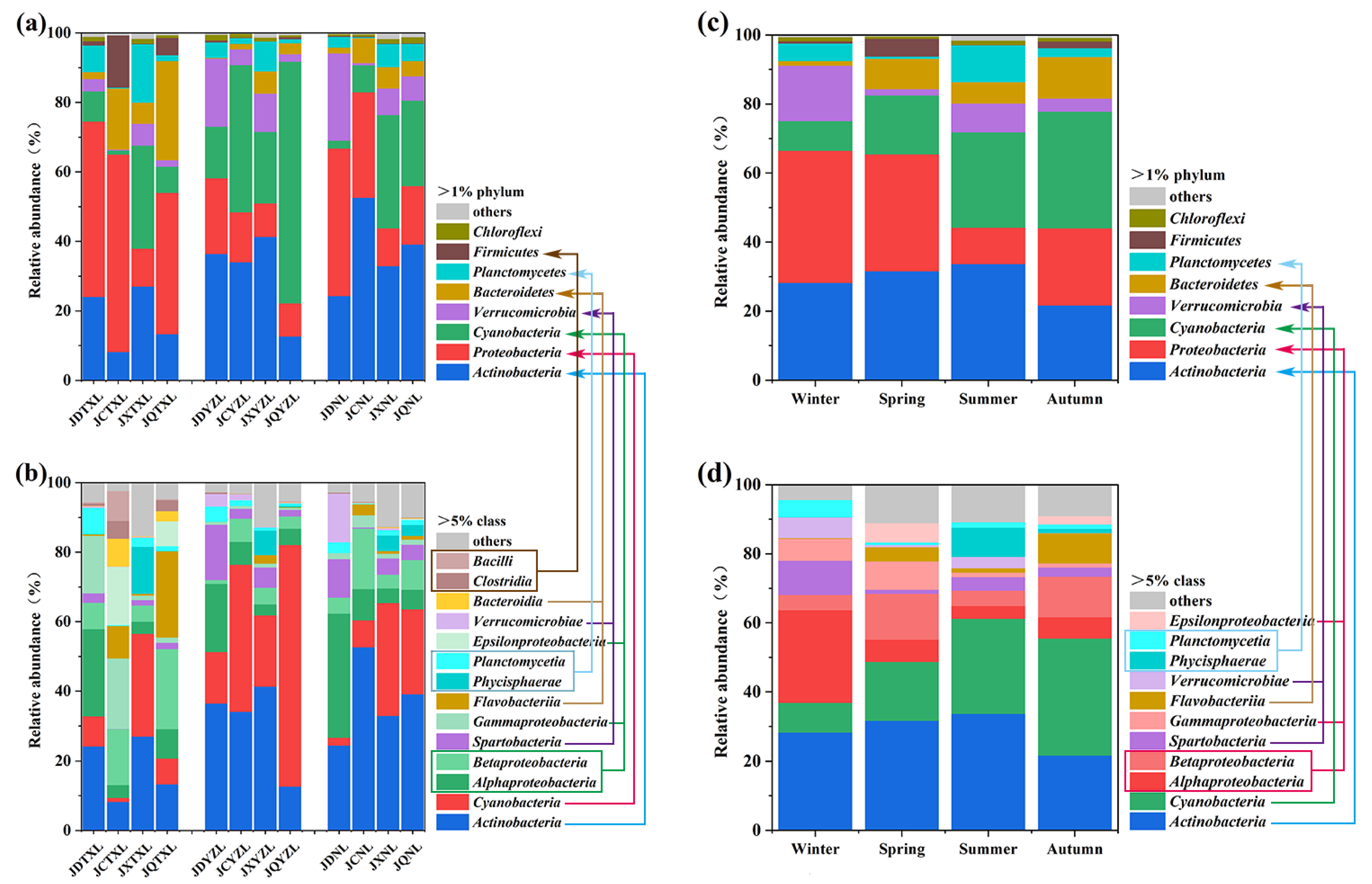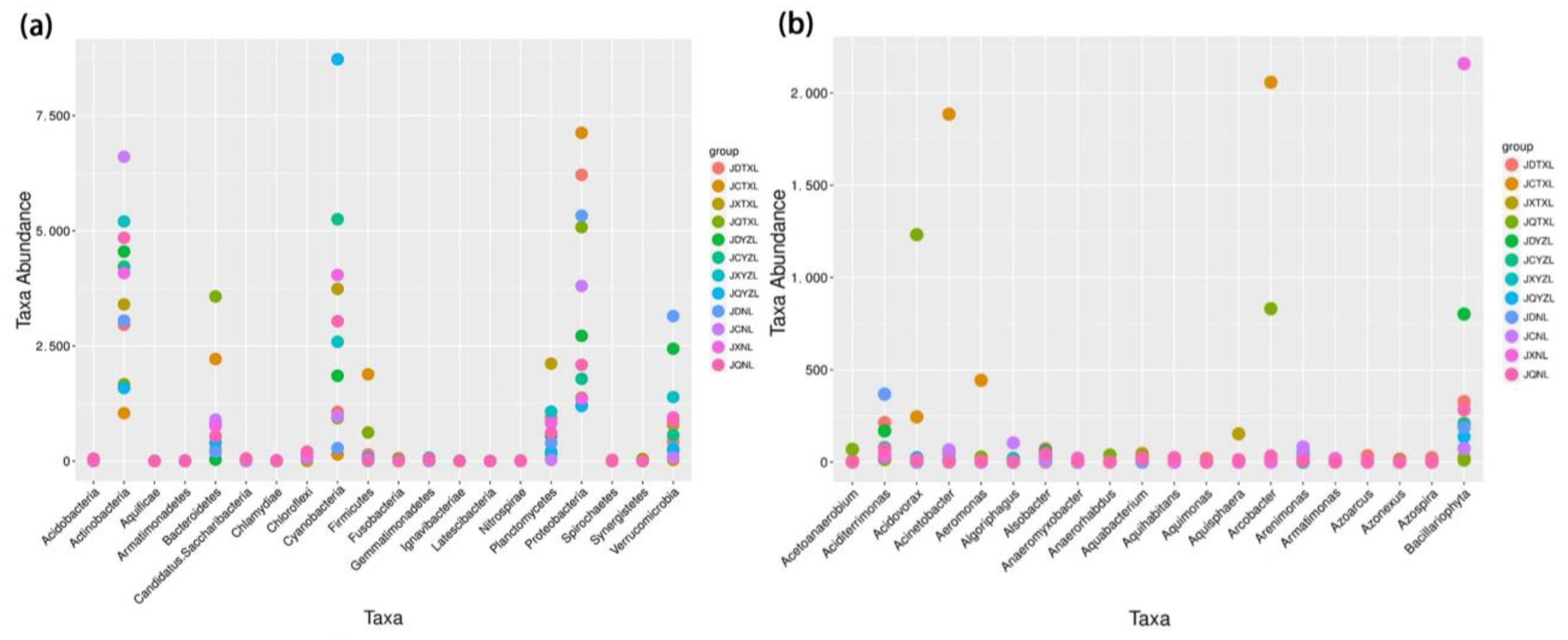Seasonal Succession of Bacterial Communities in Three Eutrophic Freshwater Lakes
Abstract
:1. Introduction
2. Materials and Methods
2.1. Study Area and Sample Collection
2.2. Determination of Water Quality Indices
2.3. Microbial Community Analysis
3. Results and Discussion
3.1. Water Properties
3.2. Operational Taxonomic Units, Bacterial Abundance and Diversity
3.3. Seasonal Microbial Community Structure
3.4. Eutrophication Assessment from the Microbial Aspect
3.5. Relationship between N/P Ratio and Seasonal Eutrophication
3.6. Relationships between Bacterial Community and Water Quality
4. Conclusions
Author Contributions
Funding
Institutional Review Board Statement
Data Availability Statement
Conflicts of Interest
References
- Yang, B.; Ke, X. Analysis on urban lake change during rapid urbanization using a synergistic approach: A case study of Wuhan, China. Phys. Chem. Earth Parts A/B/C 2015, 89, 127–135. [Google Scholar] [CrossRef]
- Wong, C.P.; Jiang, B.; Bohn, T.J.; Lee, K.N.; Lettenmaier, D.P.; Ma, D.; Ouyang, Z. Lake and wetland ecosystem services measuring water storage and local climate regulation. Water Resour. Res. 2017, 53, 3197–3223. [Google Scholar] [CrossRef] [Green Version]
- Feng, L.; Hou, X.; Zheng, Y. Monitoring and understanding the water transparency changes of fifty large lakes on the Yangtze Plain based on long-term MODIS observations. Remote Sens. Environ. 2019, 221, 675–686. [Google Scholar] [CrossRef]
- Eom, H.; Borgatti, D.; Paerl, H.W.; Park, C. Formation of Low-Molecular-Weight Dissolved Organic Nitrogen in Predenitrification Biological Nutrient Removal Systems and Its Impact on Eutrophication in Coastal Waters. Environ. Sci. Technol. 2017, 51, 3776–3783. [Google Scholar] [CrossRef]
- Xu, H.; Paerl, H.W.; Qin, B.; Zhu, G.; Gaoa, G. Nitrogen and phosphorus inputs control phytoplankton growth in eutrophic Lake Taihu, China. Limnol. Oceanogr. 2010, 55, 420–432. [Google Scholar] [CrossRef] [Green Version]
- Ji, B.; Zhu, L.; Wang, S.; Qin, H.; Ma, Y.; Liu, Y. A novel micro-ferrous dosing strategy for enhancing biological phosphorus removal from municipal wastewater. Sci. Total Environ. 2020, 704, 135453. [Google Scholar] [CrossRef]
- Hahn, M.W. The microbial diversity of inland waters. Curr. Opin. Biotechnol. 2006, 17, 256–261. [Google Scholar] [CrossRef]
- Yadav, A.N.; Yadav, N.; Kour, D.; Kumar, A.; Yadav, K.; Kumar, A.; Rastegari, A.A.; Sachan, S.G.; Singh, B.; Chauhan, V.S.; et al. Chapter 1-Bacterial community composition in lakes. In Freshwater Microbiology; Bandh, S.A., Shafi, S., Shameem, N., Eds.; Academic Press: Cambridge, MA, USA, 2019; pp. 1–71. [Google Scholar]
- Hagen, M.; Kissling, W.D.; Rasmussen, C.; De Aguiar, M.A.M.; Brown, L.E.; Carstensen, D.W.; Alves-Dos-Santos, I.; Dupont, Y.L.; Edwards, F.K.; Genini, J.; et al. Biodiversity, Species Interactions and Ecological Networks in a Fragmented World. In Advances in Ecological Research; Jacob, U., Woodward, G., Eds.; Academic Press: Cambridge, MA, USA, 2012; Volume 46, pp. 89–210. [Google Scholar]
- Drury, B.; Rosi-Marshall, E.; Kelly, J.J. Wastewater treatment effluent reduces the abundance and diversity of benthic bacterial communities in urban and suburban rivers. Appl. Environ. Microbiol. 2013, 79, 1897–1905. [Google Scholar] [CrossRef] [Green Version]
- Jiao, C.; Zhao, D.; Zeng, J.; Guo, L.; Yu, Z. Disentangling the seasonal co-occurrence patterns and ecological stochasticity of planktonic and benthic bacterial communities within multiple lakes. Sci. Total Environ. 2020, 740, 140010. [Google Scholar] [CrossRef]
- Ji, B.; Yang, K.; Zhu, L.; Jiang, Y.; Wang, H.; Zhou, J.; Zhang, H. Aerobic denitrification: A review of important advances of the last 30 years. Biotechnol. Bioproc. E 2015, 20, 643–651. [Google Scholar] [CrossRef]
- Wang, Y.; Wang, H.; Wang, X.; Xiao, Y.; Zhou, Y.; Su, X.; Cai, J.; Sun, F. Resuscitation, isolation and immobilization of bacterial species for efficient textile wastewater treatment: A critical review and update. Sci. Total Environ. 2020, 730, 139034. [Google Scholar] [CrossRef]
- Ji, B.; Zhang, M.; Gu, J.; Ma, Y.; Liu, Y. A self-sustaining synergetic microalgal-bacterial granular sludge process towards energy-efficient and environmentally sustainable municipal wastewater treatment. Water Res. 2020, 179, 115884. [Google Scholar] [CrossRef]
- Wang, S.; Ji, B.; Cui, B.; Ma, Y.; Guo, D.; Liu, Y. Cadmium-effect on performance and symbiotic relationship of microalgal-bacterial granules. J. Clean. Prod. 2021, 282, 125383. [Google Scholar] [CrossRef]
- Niedringhaus, T.P.; Milanova, D.; Kerby, M.B.; Snyder, M.P.; Barron, A.E. Landscape of Next-Generation Sequencing Technologies. Anal. Chem. 2011, 83, 4327–4341. [Google Scholar] [CrossRef] [PubMed] [Green Version]
- Xue, J.; Schmitz, B.W.; Caton, K.; Zhang, B.; Zabaleta, J.; Garai, J.; Taylor, C.M.; Romanchishina, T.; Gerba, C.P.; Pepper, I.L.; et al. Assessing the spatial and temporal variability of bacterial communities in two Bardenpho wastewater treatment systems via Illumina MiSeq sequencing. Sci. Total Environ. 2019, 657, 1543–1552. [Google Scholar] [CrossRef] [PubMed]
- Liu, Z.; Zhou, A.; Liu, H.; Wang, S.; Liu, W.; Wang, A.; Yue, X. Extracellular polymeric substance decomposition linked to hydrogen recovery from waste activated sludge: Role of peracetic acid and free nitrous acid co-pretreatment in a prefermentation-bioelectrolysis cascading system. Water Res. 2020, 176, 115724. [Google Scholar] [CrossRef]
- Jiang, Y.; Shang, Y.; Gong, T.; Hu, Z.; Yang, K.; Shao, S. High concentration of Mn2+ has multiple influences on aerobic granular sludge for aniline wastewater treatment. Chemosphere 2020, 240, 124945. [Google Scholar] [CrossRef]
- Xie, G.; Tang, X.; Shao, K.; Hu, Y.; Liu, H.; Martin, R.M.; Gao, G. Spatiotemporal patterns and environmental drivers of total and active bacterial abundances in Lake Taihu, China. Ecol. Indic. 2020, 114, 106335. [Google Scholar] [CrossRef]
- Zhu, C.; Zhang, J.; Nawaz, M.Z.; Mahboob, S.; Al-Ghanim, K.A.; Khan, I.A.; Lu, Z.; Chen, T. Seasonal succession and spatial distribution of bacterial community structure in a eutrophic freshwater Lake, Lake Taihu. Sci. Total Environ. 2019, 669, 29–40. [Google Scholar] [CrossRef]
- Newton, R.J.; McMahon, K.D. Seasonal differences in bacterial community composition following nutrient additions in a eutrophic lake. Environ. Microbiol. 2011, 13, 887–899. [Google Scholar] [CrossRef]
- Ji, B.; Zhu, L.; Wang, S.; Liu, Y. Temperature-effect on the performance of non-aerated microalgal-bacterial granular sludge process in municipal wastewater treatment. J. Environ. Manag. 2021, 282, 111955. [Google Scholar] [CrossRef]
- Wang, Y.; Li, X.; Zhang, F.; Wang, W.; Xiao, R. Effects of rapid urbanization on ecological functional vulnerability of the land system in Wuhan, China: A flow and stock perspective. J. Clean. Prod. 2020, 248, 119284. [Google Scholar] [CrossRef]
- APHA. Standard Methods for the Examination of Water and Wastewater; American Public Health Association (APHA): Washington, DC, USA, 2005. [Google Scholar]
- Kratzer, C.R.; Brezonik, P.L. A carlson-type trophic state index for nitrogen in Florida lakes 1. JAWRA J. Am. Water Resour. Assoc. 1981, 17, 713–715. [Google Scholar] [CrossRef]
- Carlson, R.E. A trophic state index for lakes 1. Limnol. Oceanogr. 1977, 22, 361–369. [Google Scholar] [CrossRef] [Green Version]
- Ji, B.; Liang, J.; Ma, Y.; Zhu, L.; Liu, Y. Bacterial community and eutrophic index analysis of the East Lake. Environ. Pollut. 2019, 252, 682–688. [Google Scholar] [CrossRef]
- Ji, B.; Liang, J.; Chen, R. Bacterial eutrophic index for potential water quality evaluation of a freshwater ecosystem. Environ. Sci. Pollut. Res. 2020, 27, 32449–32455. [Google Scholar] [CrossRef] [PubMed]
- Ji, B.; Qin, H.; Guo, S.; Chen, W.; Zhang, X.; Liang, J. Bacterial communities of four adjacent fresh lakes at different trophic status. Ecotox. Environ. Safe 2018, 157, 388–394. [Google Scholar] [CrossRef]
- Ji, B.; Wang, S.; Guo, D.; Pang, H. Comparative and comprehensive analysis on bacterial communities of two full-scale wastewater treatment plants by second and third-generation sequencing. Bioresour. Technol. Rep. 2020, 11, 100450. [Google Scholar] [CrossRef]
- The Ministry of Environmental Protection of the People’s Republic of China. Environmental Quality Standard for Surface Water GB3838-2002; China Environmental Science Press Beijing: Beijing, China, 2002.
- Nowlin, W.H.; Evarts, J.L.; Vanni, M.J. Release rates and potential fates of nitrogen and phosphorus from sediments in a eutrophic reservoir. Freshwater. Biol. 2005, 50, 301–322. [Google Scholar] [CrossRef]
- Paruch, L.; Paruch, A.M.; Eiken, H.G.; Skogen, M.; Sørheim, R. Seasonal dynamics of lotic bacterial communities assessed by 16S rRNA gene amplicon deep sequencing. Sci. Rep. UK 2020, 10, 16399. [Google Scholar] [CrossRef]
- Collins, R.E.; Rocap, G.; Deming, J.W. Persistence of bacterial and archaeal communities in sea ice through an Arctic winter. Environ. Microbiol. 2010, 12, 1828–1841. [Google Scholar] [CrossRef] [PubMed] [Green Version]
- Lv, Y.; Zhou, Y.; Chen, X.; Zhao, T.; Liu, T.; He, X.; Liu, J.; Ye, X. Study on indoor and outdoor permeability coefficients and bacterial components, sources of fine particles in severe cold region of China. Sustain. Cities Soc. 2020, 55, 102020. [Google Scholar] [CrossRef]
- van Teeseling, M.C.F.; Mesman, R.J.; Kuru, E.; Espaillat, A.; Cava, F.; Brun, Y.V.; VanNieuwenhze, M.S.; Kartal, B.; van Niftrik, L. Anammox Planctomycetes have a peptidoglycan cell wall. Nat. Commun. 2015, 6, 6878. [Google Scholar] [CrossRef] [PubMed] [Green Version]
- Dosta, J.; Fernández, I.; Vázquez-Padín, J.R.; Mosquera-Corral, A.; Campos, J.L.; Mata-Álvarez, J.; Méndez, R. Short- and long-term effects of temperature on the Anammox process. J. Hazard. Mater. 2008, 154, 688–693. [Google Scholar] [CrossRef] [PubMed]
- Zhao, J.; Wang, X.; Li, X.; Jia, S.; Peng, Y. Advanced nutrient removal from ammonia and domestic wastewaters by a novel process based on simultaneous partial nitrification-anammox and modified denitrifying phosphorus removal. Chem. Eng. J. 2018, 354, 589–598. [Google Scholar] [CrossRef]
- Carpenter, S.R. Phosphorus control is critical to mitigating eutrophication. Proc. Natl. Acad. Sci. USA 2008, 105, 11039–11040. [Google Scholar] [CrossRef] [Green Version]
- Guo, D.; Liang, J.; Chen, W.; Wang, J.; Ji, B.; Luo, S. Bacterial Community Analysis of Two Neighboring Freshwater Lakes Originating from One Lake. Pol. J. Environ. Stud. 2021, 30, 111–117. [Google Scholar] [CrossRef]
- Ma, J.; Qin, B.; Wu, P.; Zhou, J.; Niu, C.; Deng, J.; Niu, H. Controlling cyanobacterial blooms by managing nutrient ratio and limitation in a large hyper-eutrophic lake: Lake Taihu, China. J. Environ. Sci. China 2015, 27, 80–86. [Google Scholar] [CrossRef] [PubMed]
- Haakonsson, S.; Rodríguez-Gallego, L.; Somma, A.; Bonilla, S. Temperature and precipitation shape the distribution of harmful cyanobacteria in subtropical lotic and lentic ecosystems. Sci. Total Environ. 2017, 609, 1132–1139. [Google Scholar] [CrossRef]






| Sample ID | Season | COD (mg/L) | TN (mg/L) | TP (mg/L) | |
|---|---|---|---|---|---|
| Tangxun Lake | JDTXL | Winter | 24.28 | 9.16 | 0.35 |
| JCTXL | Spring | 26.28 | 6.22 | 0.35 | |
| JXTXL | Summer | 34.32 | 9.42 | 0.42 | |
| JQTXL | Autumn | 25.11 | 5.56 | 0.33 | |
| Yezhi Lake | JDYZL | Winter | 12.14 | 2.38 | 0.21 |
| JCYZL | Spring | 15.62 | 2.54 | 0.12 | |
| JXYZL | Summer | 15.16 | 3.01 | 0.28 | |
| JQYZL | Autumn | 14.22 | 2.43 | 0.22 | |
| Nan Lake | JDNL | Winter | 32.38 | 4.18 | 0.18 |
| JCNL | Spring | 30.39 | 2.29 | 0.16 | |
| JXNL | Summer | 33.45 | 5.16 | 0.28 | |
| JQNL | Autumn | 30.54 | 4.75 | 0.19 |
| Sample ID | Chao1 | ACE | Simpson | Shannon | |
|---|---|---|---|---|---|
| Tangxun Lake | JDTXL | 1622.14 | 1722.66 | 0.970521 | 7.85 |
| JCTXL | 935.81 | 915.27 | 0.982499 | 7.65 | |
| JXTXL | 1309.40 | 1375.19 | 0.984909 | 7.97 | |
| JQTXL | 1203.57 | 1152.77 | 0.934474 | 6.80 | |
| Yezhi Lake | JDYZL | 940.40 | 985.55 | 0.968654 | 7.04 |
| JCYZL | 944.04 | 977.53 | 0.967030 | 7.02 | |
| JXYZL | 1469.94 | 1530.30 | 0.990195 | 8.44 | |
| JQYZL | 1184.99 | 1239.24 | 0.978945 | 7.52 | |
| Nan Lake | JDNL | 990.65 | 1037.55 | 0.954592 | 6.89 |
| JCNL | 1232.44 | 1238.85 | 0.989097 | 8.12 | |
| JXNL | 1470.83 | 1492.79 | 0.985983 | 8.30 | |
| JQNL | 1363.01 | 1374.30 | 0.993332 | 8.78 |
| Index | Season | Tangxun Lake | Yezhi Lake | Nan Lake |
|---|---|---|---|---|
| N/P | Spring | 17.77 | 21.17 | 14.31 |
| Summer | 22.43 | 10.75 | 18.43 | |
| Autumn | 16.85 | 11.05 | 25.00 | |
| Winter | 26.17 | 11.33 | 23.22 | |
| AVG | 20.80 | 13.57 | 20.24 | |
| TSI | Spring | 84.72 | 70.54 | 71.87 |
| Summer | 89.03 | 77.88 | 81.77 | |
| Autumn | 83.49 | 74.59 | 78.37 | |
| Winter | 87.52 | 74.11 | 77.06 | |
| AVG | 86.19 | 74.28 | 77.27 | |
| BEI | Spring | 0.14 | 1.24 | 0.15 |
| Summer | 1.10 | 0.50 | 0.99 | |
| Autumn | 0.56 | 5.49 | 0.63 | |
| Winter | 0.36 | 0.41 | 0.09 | |
| AVG | 0.54 | 1.91 | 0.46 | |
| BEI’ | Spring | 0.25 | 2.20 | 0.26 |
| Summer | 1.62 | 0.74 | 1.46 | |
| Autumn | 0.68 | 6.64 | 0.76 | |
| Winter | 2.22 | 2.50 | 0.57 | |
| AVG | 1.19 | 3.02 | 0.76 | |
| Abundance of Luteolibacter (%) | Winter | 0.19 | 3.43 | 12.03 |
Publisher’s Note: MDPI stays neutral with regard to jurisdictional claims in published maps and institutional affiliations. |
© 2021 by the authors. Licensee MDPI, Basel, Switzerland. This article is an open access article distributed under the terms and conditions of the Creative Commons Attribution (CC BY) license (https://creativecommons.org/licenses/by/4.0/).
Share and Cite
Ji, B.; Liu, C.; Liang, J.; Wang, J. Seasonal Succession of Bacterial Communities in Three Eutrophic Freshwater Lakes. Int. J. Environ. Res. Public Health 2021, 18, 6950. https://doi.org/10.3390/ijerph18136950
Ji B, Liu C, Liang J, Wang J. Seasonal Succession of Bacterial Communities in Three Eutrophic Freshwater Lakes. International Journal of Environmental Research and Public Health. 2021; 18(13):6950. https://doi.org/10.3390/ijerph18136950
Chicago/Turabian StyleJi, Bin, Cheng Liu, Jiechao Liang, and Jian Wang. 2021. "Seasonal Succession of Bacterial Communities in Three Eutrophic Freshwater Lakes" International Journal of Environmental Research and Public Health 18, no. 13: 6950. https://doi.org/10.3390/ijerph18136950
APA StyleJi, B., Liu, C., Liang, J., & Wang, J. (2021). Seasonal Succession of Bacterial Communities in Three Eutrophic Freshwater Lakes. International Journal of Environmental Research and Public Health, 18(13), 6950. https://doi.org/10.3390/ijerph18136950







